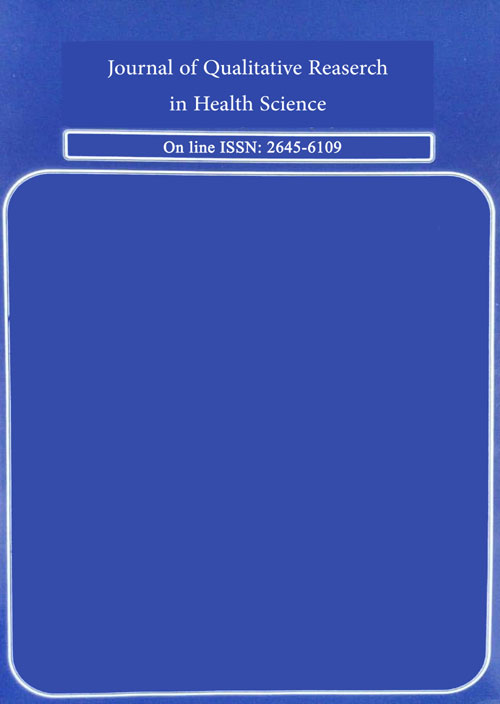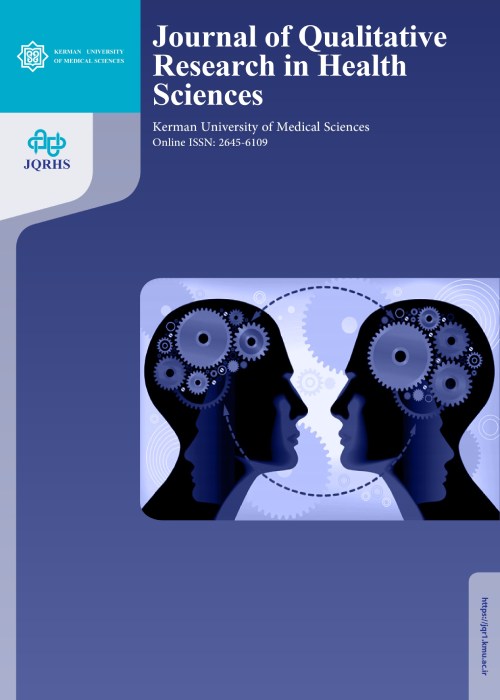فهرست مطالب

Journal of Qualitative Research in Health Sciences
Volume:9 Issue: 2, Summer 2020
- تاریخ انتشار: 1399/06/30
- تعداد عناوین: 8
-
-
Pages 79-90IntroductionCommunity development and its prompting problems made it known that we are significantly in need of mental health specialists, especially counselors. The aim of the present study was to probe the quality of successful counselors' perceptions of the performance dimensions of therapeutic competence.MethodsThis study was conducted using the phenomenological approach. The purposive sampling method was adopted to choose 20 counselors (interviewees) to participate in the study from amongcounselors at Shamim Counseling Centers of Islamic Revolutionary Guard Corps in 2016.All the interviews were tape-recorded and then transcribed line by line. Finally, they were analyzed in accordance with interpretation analysis method.ResultsIn this paper, 20 semi-structured interviews were conducted. The analyzed data of the interviews led to the identification of 8 main themes (Theoretical proficiency, Interdisciplinary knowledge, Insight into context, Specialization in intervention levels, Clinical specialization, Multicultural competence, Focusing on common therapeutic factors and Holism) and 30 sub-themes in terms of performance dimensions of therapeutic competence.ConclusionThe results of this study can help develop counselors' educational programs and evaluate counselors' level of competence and self-efficiency in the recruitment centers.Keywords: counseling, Counselor, Performance Dimensions, Competence, Qualitative study
-
Pages 91-100IntroductionSadness is the most important natural emotion of human beings. The feeling of sadness is experienced throughout the private and public life of mankind. Therefore, the present study aimed to explain the concept of grief by referring to the Holy Qur’an.MethodsThis study was conducted through qualitative content analysis method. From among the Qur’anic concepts relevant to sadness, which were collected from the whole Qur’an, 60 concepts were selected via targeted sampling for analysis.ResultsFrom the analysis of the Qur’anic concepts of sadness, six main categories including “physiology”, “psychology”, “emotion”, “spirituality”, “remedy”, and “consequences” emerged.ConclusionAccording to the results, it can be inferred that sadness in the Holy Qur’an is a multidimensional concept and various structures have been used to explain it. That is why all human beings, with respect to the high incidence of depression and sadness, have to pay more attention to this concept, and for being treated, they must accept that all things in the universe occur under God’s lordship.Keywords: Holy Qur’an, Sadness, Physiology, Psychology, Emotion
-
Pages 101-110IntroductionEducation in school is considered to be the most important part of every adolescent's life, and exposure to a traumatic experience in this disturbing period can greatly affect it. However, trauma does not only lead to negative consequences and psychological trauma, as sometimes it also induces positive changes called “post-traumatic growth”. The main objective of this study was to explore the students' lived experience of academic factors affecting their post-traumatic growthMethodsThis qualitative study employed a descriptive phenomenological method. The participants were 15 male and female adolescent students sponsored by an NGO supporting orphans in Isfahan and were selected based on purposive sampling. The data were collected using semi-structured and in-depth interviews, and analyzed by Colaizzi’s 7-step method in MAXQDA software.ResultsAfter data analysis, 296 primary codes were extracted and classified into 11 categories. Then, 4 main themes including the school support network, teacher's role, school attachment, and academic well-being appeared in the participants' experiences.ConclusionIt can be concluded that post-traumatic growth after the father’s sudden death among adolescents is affected by several academic factors such as the school support network, teacher's role, school attachment, and academic well-being. Therefore, schools can provide a suitable context for students to reach this growth by developing and implementing appropriate counseling and intervention programs.Keywords: Adolescent, growth, Phenomenology, qualitative research
-
Pages 111-122IntroductionOlder people are more vulnerable to physical disability, as well as mental illnesses. They also may experience challenges that can be related to Nussbaum's Central Human Functional Capabilities. The purpose of this study was to explore the elderly's views related to Central Human Functional Capabilities.MethodsThis study used a qualitative approach to understand older people's perspectives on capabilities. Purposive sampling was used to select nineteen older women aged 65 to 79 years. The data collected through semi-structured interviews were thematically analyzed.ResultsEighteen themes emerged by thematic analysis of the ten functional capabilities, including life (life expectancy, life satisfaction), bodily health (functional independence, nutrition, and accessibility), bodily integrity (independent decision-making and dealing with insults), senses, imagination and thought (material interests and religious beliefs), emotions (love of children), practical reason (daily routine), affiliation (respect for others, empathy for others, gender discrimination), other species (interest in nature and flowers), play (interest in recreational activities), and control over one's environment (political participation, being dependent).ConclusionDespite the importance of all the capabilities from the viewpoint of the elderly, the "bodily health" and "bodily integrity" capabilities were of particular importance. Health policymakers should recognize the Central Human Functional Capabilities and allocate resources and services that best promote these capabilities for the elderly.Keywords: elderly, Social participation, Central Human Functional Capabilities
-
Pages 123-132Introduction
Social media sites have provided facilities. However, these networks have also been associated with adverse effects including social media addiction. The present study explored the effects of mothers’ social media addiction on marital satisfaction.
MethodsThis qualitative study was conducted based on the grounded theory and the data were collected through semi-structured interviews. The research sample consisted of mothers who completed the Social Media Harmful Use Scale and were dependent on social networks. The participants in the research sample were selected using purposive sampling.
ResultsThe collected data were analyzed using theoretical coding including open, axial, and selective coding. Accordingly, 4 main categories, 9 subcategories, and 34 themes were identified in the data. The results of the study showed that the dependence on social media is the core category in this study. Other categories included the interference of the use of social media with the relationships with family members, the quality of the relationship with family members (spouse and child), and children's behavioral problems (externalizing problems, internalizing problems, and communication problems).
ConclusionThe present study showed that the mothers’ dependence on social media is associated with low marital satisfaction as well as an adverse relationship with their husband and children, which is related to their children's behavioral problems. According to the findings, dependence on social media paves the way for problems such as interference of the use of social media with the relationship with the spouse and children, the quality of the relationships, and children's behavioral problems.
Keywords: Addiction, Social media, Marital satisfaction, children, Behavioral problems -
Pages 133-144Introduction
Domestic violence is the most common form of violence against women. Negative health outcomes caused by domestic violence have been recognized as a public health problem with extensive effects on society. The main objective of this study was to explore Iranian couples’ experiences of domestic violence.
MethodsThis study was carried out through a qualitative approach and a conventional content analysis method in 2015 in Mashhad, Iran. Fifteen couples (15 women and 15 men) were selected from five health centers in Mashhad using purposive sampling. Data were collected through individual in-depth semi-structured interviews with the participants about their perceptions and experiences of factors underlying domestic violence. The interviews were transcribed verbatim and analyzed using Graneheim and Lundman's content analysis approach with MAXQDA software.
ResultsThe results of this study revealed three main themes including social factors affecting violence (the family’s economic position, culture and values, and social support), interpersonal relations (the type of marriage and life skills), and personal factors (intrinsic factors and acquired factors).
ConclusionGiven that social, interpersonal, and personal factors such as economic problems, social culture, low social support, low education levels, addiction, and the absence of life skills can lead to the outbreak of domestic violence among couples, there is a need to train couples to adopt effective strategies to reduce domestic violence in the family and seek help from support centers.
Keywords: Domestic violence, Iranian women, contributing factors, qualitative research -
Pages 145-155IntroductionMenstrual experience is one of the most important physical experiences of girls. The main question in the present study was not only how to understand and give meaning to this experience, but also how it could be related to social and cultural fields.MethodsThis qualitative study was carried out using grounded theory method and through encoding phenomenological interviews with 24 girls who lived in Tehran and experienced menstruation.ResultsFive main categories and sixteen sub-categories were identified; The main categories included “Context of menstrual experience”, “Causal conditions of menstrual experience”, “Intervening conditions of menstrual experience”, “Action strategies of menstrual experience”, and “Consequences of menstrual experience”.ConclusionThe results of the present study indicated that the menstrual experience paves the way for girls to construe their body as an object for manipulation. From this perspective, though menstrual experiences are similar, they can be distinguished from one another whether by regarding menstruation as a defect in the normal functioning of the ideal body that needs to be concealed or as a natural event indicative of a feminine body with reproductive capacity.Keywords: Physical experience, Menstruation, Phenomenology, Girls
-
Pages 155-165IntroductionRegular cervical cancer screening is an effective strategy to reduce the incidence and mortality rate of this disease. Therefore, the present study aimed to explain facilitators and barriers to performing regular Pap smear tests in Iranian women.MethodsThis qualitative study was performed in 2017 in medical centers in Hamadan. The participants in this study were 23 women and 8 health care workers who were selected through purposive sampling. The inclusion criteria were the willingness to participate in the study and having the ability to communicate properly. The data were collected using in-depth semi-structured interviews and analyzed using the qualitative content analysis method with MAXQDA10 software.ResultsThree main concepts were recognized as facilitators and barriers to regular Pap smear testing: (1) Belief vs. disbelief in the possibility of cancer control and treatment, (2) Priority vs. non-priority of health in life, and (3) Ability vs. inability to overcome the challenges ahead.ConclusionGiven the results of the study, it is necessary to establish policies to increase people's sensitivity to testing and the dominance of screening culture in society. Health officials also need to support training programs to promote women's understanding of the importance and impact of early diagnosis in controlling and treating cervical cancer and to develop and implement programs to reduce or eliminate financial, time, and emotional barriers.Keywords: Cervical cancer, Regular screening, Pap smear test, Facilitators, barriers, Iran


